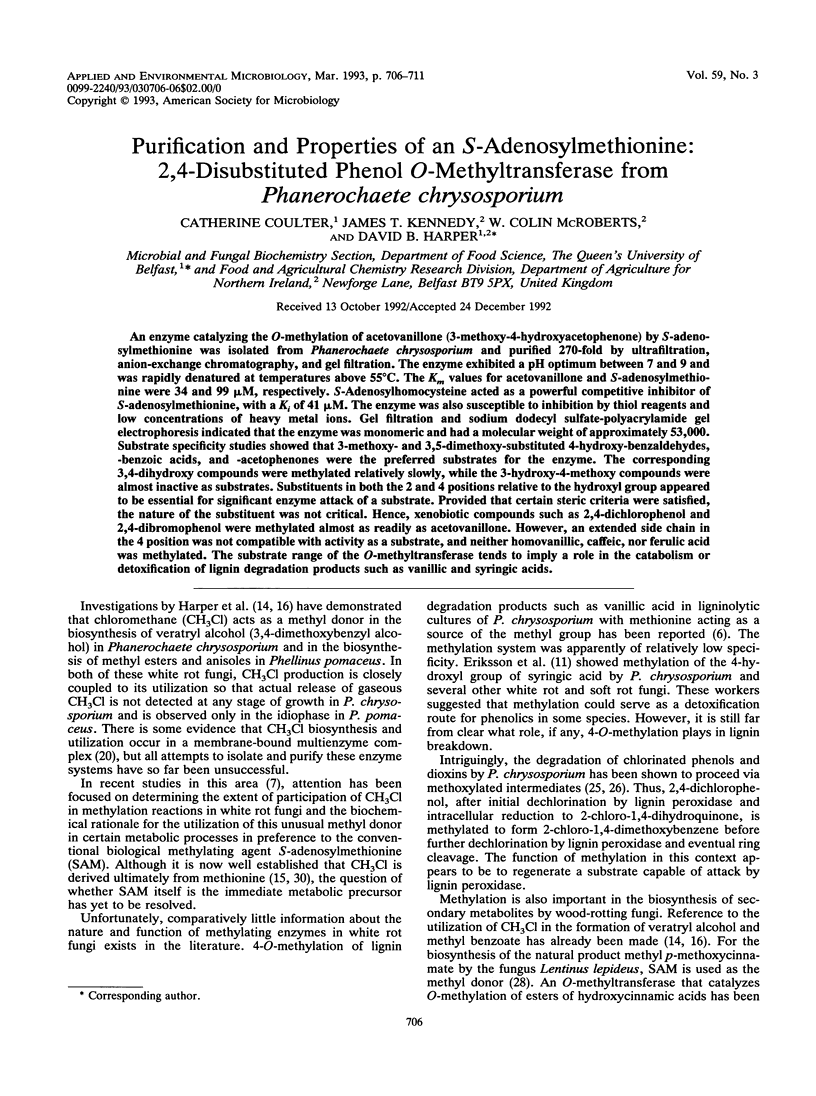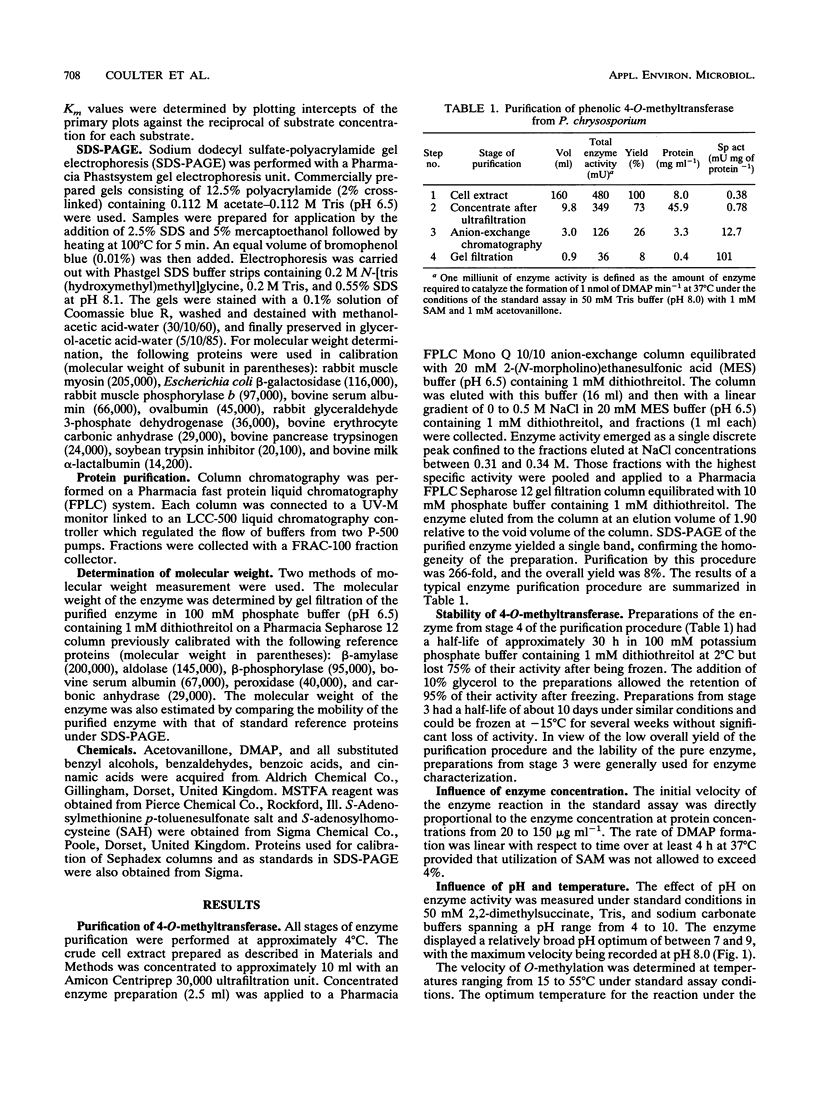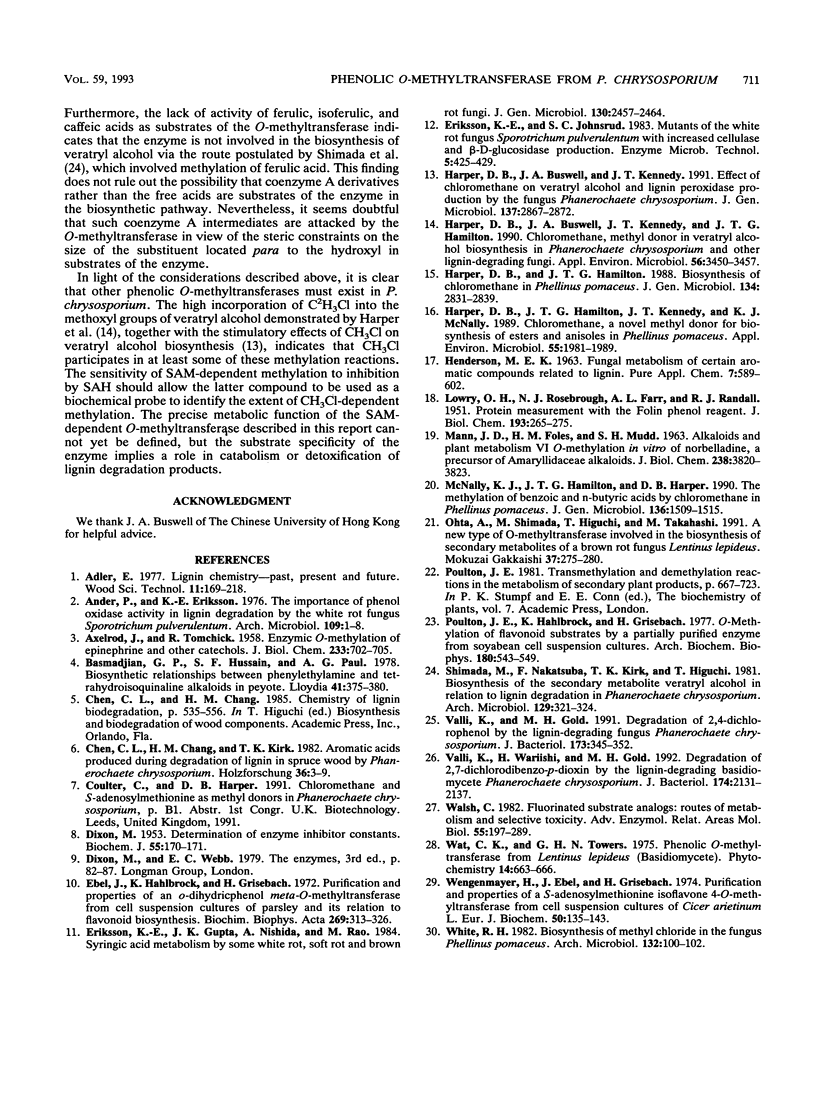Abstract
An enzyme catalyzing the O-methylation of acetovanillone (3-methoxy-4-hydroxyacetophenone) by S-adeno-sylmethionine was isolated from Phanerochaete chrysosporium and purified 270-fold by ultrafiltration, anion-exchange chromatography, and gel filtration. The enzyme exhibited a pH optimum between 7 and 9 and was rapidly denatured at temperatures above 55°C. The Km values for acetovanillone and S-adenosylmethionine were 34 and 99 μM, respectively. S-Adenosylhomocysteine acted as a powerful competitive inhibitor of S-adenosylmethionine, with a Ki of 41 μM. The enzyme was also susceptible to inhibition by thiol reagents and low concentrations of heavy metal ions. Gel filtration and sodium dodecyl sulfate-polyacrylamide gel electrophoresis indicated that the enzyme was monomeric and had a molecular weight of approximately 53,000. Substrate specificity studies showed that 3-methoxy- and 3,5-dimethoxy-substituted 4-hydroxy-benzaldehydes, -benzoic acids, and -acetophenones were the preferred substrates for the enzyme. The corresponding 3,4-dihydroxy compounds were methylated relatively slowly, while the 3-hydroxy-4-methoxy compounds were almost inactive as substrates. Substituents in both the 2 and 4 positions relative to the hydroxyl group appeared to be essential for significant enzyme attack of a substrate. Provided that certain steric criteria were satisfied, the nature of the substituent was not critical. Hence, xenobiotic compounds such as 2,4-dichlorophenol and 2,4-dibromophenol were methylated almost as readily as acetovanillone. However, an extended side chain in the 4 position was not compatible with activity as a substrate, and neither homovanillic, caffeic, nor ferulic acid was methylated. The substrate range of the O-methyltransferase tends to imply a role in the catabolism or detoxification of lignin degradation products such as vanillic and syringic acids.
Full text
PDF





Selected References
These references are in PubMed. This may not be the complete list of references from this article.
- AXELROD J., TOMCHICK R. Enzymatic O-methylation of epinephrine and other catechols. J Biol Chem. 1958 Sep;233(3):702–705. [PubMed] [Google Scholar]
- DIXON M. The determination of enzyme inhibitor constants. Biochem J. 1953 Aug;55(1):170–171. doi: 10.1042/bj0550170. [DOI] [PMC free article] [PubMed] [Google Scholar]
- Ebel J., Hahlbrock K., Grisebach H. Purification and properties of an o-dihydricphenol meta-O-methyltransferase from cell suspension cultures of parsley and its relation to flavonoid biosynthesis. Biochim Biophys Acta. 1972 May 12;268(2):313–326. doi: 10.1016/0005-2744(72)90326-9. [DOI] [PubMed] [Google Scholar]
- Harper D. B., Buswell J. A., Kennedy J. T., Hamilton J. T. Chloromethane, Methyl Donor in Veratryl Alcohol Biosynthesis in Phanerochaete chrysosporium and Other Lignin-Degrading Fungi. Appl Environ Microbiol. 1990 Nov;56(11):3450–3457. doi: 10.1128/aem.56.11.3450-3457.1990. [DOI] [PMC free article] [PubMed] [Google Scholar]
- Harper David B., Hamilton John T. G., Kennedy James T., McNally Kieran J. Chloromethane, a Novel Methyl Donor for Biosynthesis of Esters and Anisoles in Phellinus pomaceus. Appl Environ Microbiol. 1989 Aug;55(8):1981–1989. doi: 10.1128/aem.55.8.1981-1989.1989. [DOI] [PMC free article] [PubMed] [Google Scholar]
- LOWRY O. H., ROSEBROUGH N. J., FARR A. L., RANDALL R. J. Protein measurement with the Folin phenol reagent. J Biol Chem. 1951 Nov;193(1):265–275. [PubMed] [Google Scholar]
- MANN J. D., FALES H. M., MUDD S. H. ALKALOIDS AND PLANT METABOLISM. VI. O-METHYLATION IN VITRO OF NORBELLADINE, A PRECURSOR OF AMARYLLIDACEAE ALKALOIDS. J Biol Chem. 1963 Nov;238:3820–3823. [PubMed] [Google Scholar]
- Poulton J. E., Hahlbrock K., Grisebach H. O-Methylation of flavonoid substrates by a partially purified enzyme from soybean cell suspension cultures. Arch Biochem Biophys. 1977 Apr 30;180(2):543–549. doi: 10.1016/0003-9861(77)90071-6. [DOI] [PubMed] [Google Scholar]
- Valli K., Gold M. H. Degradation of 2,4-dichlorophenol by the lignin-degrading fungus Phanerochaete chrysosporium. J Bacteriol. 1991 Jan;173(1):345–352. doi: 10.1128/jb.173.1.345-352.1991. [DOI] [PMC free article] [PubMed] [Google Scholar]
- Valli K., Wariishi H., Gold M. H. Degradation of 2,7-dichlorodibenzo-p-dioxin by the lignin-degrading basidiomycete Phanerochaete chrysosporium. J Bacteriol. 1992 Apr;174(7):2131–2137. doi: 10.1128/jb.174.7.2131-2137.1992. [DOI] [PMC free article] [PubMed] [Google Scholar]
- Walsh C. Fluorinated substrate analogs: routes of metabolism and selective toxicity. Adv Enzymol Relat Areas Mol Biol. 1983;55:197–289. doi: 10.1002/9780470123010.ch3. [DOI] [PubMed] [Google Scholar]
- Wengenmayer H., Ebel J., Grisebach H. Purification and properties of a S-adenosylmethionine: isoflavone 4'-O-methyltransferase from cell suspension cultures of Cicer arietinum L. Eur J Biochem. 1974 Dec 16;50(1):135–143. doi: 10.1111/j.1432-1033.1974.tb03881.x. [DOI] [PubMed] [Google Scholar]


